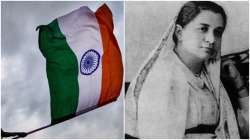Independence Day 2022: First Indian flag was hoisted 40 years before freedom - here's the story
Independence Day 2022: Freedom fighter Bhikaji Patel-Cama hoisted the Indian flag in Germany and issued a simple appeal to the world to support India's struggle for independence.

Independence Day 2022: India is celebrating Azadi Ka Amrit Mahotsav this year, as the country marks 75 years of achieving independence. To mark this occasion, Prime Minister Narendra Modi even urged all to change their display pictures on social media platforms to the tricolour. The national flag or the tri-colour holds great significance when it comes to representing India. But did you know, that the first Indian flag was hoisted 40 years before the country's independence? It was done by legendary freedom-fighter Bhikaiji Patel-Cama, an Indian feminist-nationalist, and one of the very few women at the forefront of the freedom movement in India, back at the beginning of the 20th century.
She hoisted the Indian flag in Germany and issued a simple appeal to the world to support India's struggle for independence. The moment is etched in golden letters in the country's history. It was on August 2, 1907, when 46-year-old Bhikaiji Cama was in Stuttgart attending the International Socialist Conference - during her forced sojourn in Europe, US and later north Africa - that she took the opportunity to unveil the Indian flag before the world and sought their support for her motherland's freedom from the British oppression.
Cama takes India's freedom struggle story on global platform
While in Germany, Cama spoke about the horrors of the famine that had ravaged India, the flouting of human rights, and equality by Britain and demanded independence from the British Raj. The flag, later smuggled into India and currently housed at a Pune museum, was jointly designed by Bhikaiji Cama and Shyamji Krishnavarma and later inspired the national tricolour that was created for independent India.
Her flag comprised a green stripe at the top with eight lotuses in bloom symbolising the country's provinces, 'Bande Mataram' scribbled at the centre in Hindi on the saffron stripe, along with a sun on the left and a crescent moon on the right, symbolising the two dominant faiths - Hinduism and Islam - in the country. That small act - coming from a woman - succeeded in drawing big attention to India's plight, its yearning and struggle for independence, before the global comity, embarrassing the British rulers.
Who was Bhikaji Patel-Cama?
Born into a wealthy Zoroastrian (Parsi) merchant family to Sorabji and Jaijibai Patel on September 24, 1861, Bhikaiji Patel was drawn to the fledgling Indian freedom struggle, at a very young age, as it was taking baby steps after the historic First War of Independence of 1857. Educated at the famed Alexandra Girls English Institution, Byculla and blessed with the ability to pick up languages quickly - which later helped her espouse India's cause in different countries - she got married to Rustomji Cama, a famous pro-Raj lawyer in 1885.
However, the couple remained at odds, as she was a nationalist with her disdain for the British and he had unabashed adulation for the Raj. The marriage was literally on the rocks as both remained immersed in their respective interests.
During the devastating bubonic plague that broke in the Bombay Presidency in 1896, Bhikaiji Cama volunteered to help the infected but ended up catching the fatal disease, and though she survived, it took an enormous toll on her frail health.
As doctors suggested she go to Europe for convalescence, she left the Indian shores in 1902 - blissfully unaware at that time, of what would be a long, forced foreign exile and travel that would last for over 3 decades, starting with - ironically, London.
It proved worthwhile as she met one of the doyens of the freedom struggle Dadabhai Naoroji and even became active with the Indian National Congress, founded on December 28, 1895, by meeting others like Lala Hardayal, Krishnavarma, addressed spirited meetings at the Hyde Park, and drummed up support for the cause.
Bhikaji Patel-Cama's contribution to 'Vande Mataram'
In 1909, Cama tactically moved to France and met other stalwarts like Munchershah Burjorji Godrej, Singh Rewabhai Rana, and founded the Paris Indian Society, with her home serving as the hub of Indian freedom struggle activities in Europe. Along with many other activists, they penned, printed and distributed revolutionary literature, including the banned patriotic song "Vande Mataram", and others paying tributes to martyrs like Madan Lal Dhingra.
Bhikaiji travelled to several European countries, the US and Egypt to effectively espouse the Indian cause and expose the British rule, its excesses on the Indian masses and other social-economic-political issues in a fiery style.
She had once said: "Do not forget the important role women play in building a nation". Years after her death, it proved true in the form of top Indian women leaders like the former Prime Minister Indira Gandhi, former President Pratibha Patil and the current President Droupadi Murmu.
(With IANS Inputs)